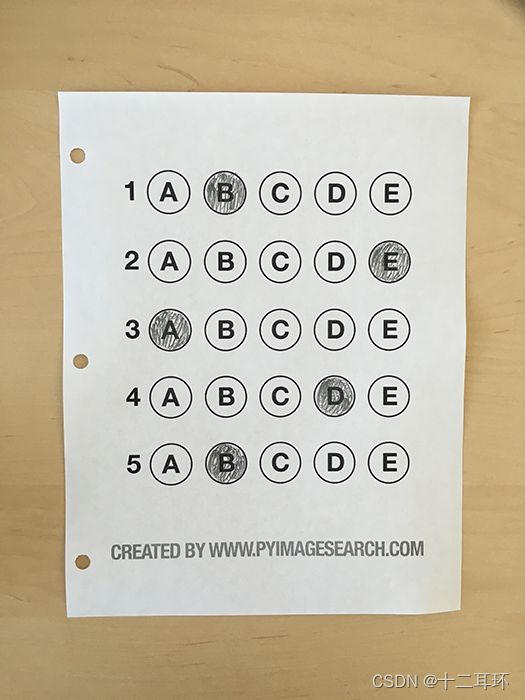opencv答题卡识别项目
直接上代码:
datika.py
# @time: 2022/2/17 18:20
# @Author: wangshubo
# @File: datika.py
# @description:
# @author_email: '[email protected]'
import cv2
import numpy as np
from myutils import sort_contours
from utilsW.utils import cvSHow, CalDistance
# 正确答案: BEADB
ANSWER_KEY = {0: 1, 1: 4, 2: 0, 3: 3, 4: 1}
def four_point_transform(image, pts):
# rect = order_points(pts)
rect = pts.squeeze().astype(np.float32)
(tl, tr, bl, br) = rect[1], rect[2], rect[0], rect[3],
# 计算输入的w和h值
widthA = CalDistance(tl, tr)
widthB = CalDistance(bl, br)
maxWidth = max(int(widthA), int(widthB))
heightA = CalDistance(tl, bl)
heightB = CalDistance(tr, br)
maxHeight = max(int(heightA), int(heightB))
# 变换后对应坐标位置
dst = np.array([
[0, 0],
[maxWidth - 1, 0],
[maxWidth - 1, maxHeight - 1],
[0, maxHeight - 1]], dtype="float32")
src_points = np.array([bl, br, tr, tl])
# 计算变换矩阵
M = cv2.getPerspectiveTransform(src_points, dst)
warped = cv2.warpPerspective(image, M, (maxWidth, maxHeight))
# 返回变换后结果
return warped
if __name__ == '__main__':
src = cv2.imread("D:/images/datika.png")
cvSHow("src", src)
gray = cv2.cvtColor(src, cv2.COLOR_BGR2GRAY)
blur_img = cv2.GaussianBlur(gray, (5, 5), 0)
cvSHow("blur_img", blur_img)
edge_img = cv2.Canny(blur_img, 75, 200)
cvSHow("edge_img", edge_img)
cnts = cv2.findContours(edge_img.copy(), cv2.RETR_EXTERNAL, cv2.CHAIN_APPROX_SIMPLE)[0]
cv2.drawContours(src, cnts, -1, (0, 0, 255), 2)
cvSHow("draw", src)
docCnt = None
if len(cnts) > 0:
cnts = sorted(cnts, key=cv2.contourArea, reverse=True) # reverse为TRUE则为降序,FALSE则为升序
for c in cnts:
peri = cv2.arcLength(c, True)
approx = cv2.approxPolyDP(c, 0.02 * peri, True) # 主要功能是把一个连续光滑曲线折线化
if len(approx) == 4:
docCnt = approx
break
#透视变换
warped = four_point_transform(gray, docCnt.reshape(4, 2))
cvSHow("warped", warped)
thresh = cv2.threshold(warped, 0, 255, cv2.THRESH_BINARY_INV | cv2.THRESH_OTSU)[1]
cvSHow("thresh", thresh)
thresh_Contours = thresh.copy()
cnts = cv2.findContours(thresh.copy(), cv2.RETR_EXTERNAL, cv2.CHAIN_APPROX_SIMPLE)[0]
cv2.drawContours(warped, cnts, -1, (0,0,255),2)
cvSHow("thresh_Contours", warped)
questionCnts = []
for c in cnts:
(x, y, w, h) = cv2.boundingRect(c)
ar = w / float(h)
if w >=20 and h >= 20 and ar >=0.9 and ar <= 1.1:
questionCnts.append(c)
questionCnts = sort_contours(questionCnts, method="top-to-bottom")[0]
correct = 0
for (q, i) in enumerate(np.arange(0, len(questionCnts), 5)):
# 排序
cnts = sort_contours(questionCnts[i:i + 5])[0]
bubbled = None
# 遍历每一个结果
for (j, c) in enumerate(cnts):
# 使用mask来判断结果
mask = np.zeros(thresh.shape, dtype="uint8")
cv2.drawContours(mask, [c], -1, 255, -1) # -1表示填充
cvSHow('mask', mask)
# 通过计算非零点数量来算是否选择这个答案
mask = cv2.bitwise_and(thresh, thresh, mask=mask)
cvSHow("mask1",mask)
total = cv2.countNonZero(mask)
# 通过阈值判断
if bubbled is None or total > bubbled[0]:
bubbled = (total, j)
# 对比正确答案
color = (0, 0, 255)
k = ANSWER_KEY[q]
# 判断正确
if k == bubbled[1]:
color = (0, 255, 0)
correct += 1
# 绘图
cv2.drawContours(warped, [cnts[k]], -1, color, 3)
score = (correct / 5.0) * 100
print("[INFO] score: {:.2f}%".format(score))
cv2.putText(warped, "{:.2f}%".format(score), (10, 30),
cv2.FONT_HERSHEY_SIMPLEX, 0.9, (0, 0, 255), 2)
cv2.imshow("Original", src)
cv2.imshow("Exam", warped)
cv2.waitKey(0)
引用文件
myutils.py
# @time: 2022/1/17 16:22
# @Author: wangshubo
# @File: myutils.py
# @description:
# @author_email: '[email protected]'
import cv2
def sort_contours(cnts, method="left-to-right"):
reverse = False
i = 0
if method == "right-to-left" or method == "bottom-to-top":
reverse = True
if method == "top-to-bottom" or method == "bottom-to-top":
i = 1
boundingBoxes = [cv2.boundingRect(c) for c in cnts] #用一个最小的矩形,把找到的形状包起来x,y,h,w
(cnts, boundingBoxes) = zip(*sorted(zip(cnts, boundingBoxes),
key=lambda b: b[1][i], reverse=reverse))
return cnts, boundingBoxes
def resize(image, width=None, height=None, inter=cv2.INTER_AREA):
dim = None
(h, w) = image.shape[:2]
if width is None and height is None:
return image
if width is None:
r = height / float(h)
dim = (int(w * r), height)
else:
r = width / float(w)
dim = (width, int(h * r))
resized = cv2.resize(image, dim, interpolation=inter)
return resized
utils.py
# @time: 2022/1/6 11:06
# @Author: wangshubo
# @File: utilsW.py
# @description: 封装的工具函数
# @author_email: '[email protected]'
import cv2 as cv
import numpy as np
def cvSHow(name, img):
cv.imshow(name, img)
cv.waitKey(0)
cv.destroyAllWindows()
#计算两点距离之和
def CalDistance(pt1, pt2):
x1, y1, x2, y2 = pt1[0], pt1[1], pt2[0], pt2[1]
distance = np.sqrt(((y2 - y1) ** 2) + ((x2 - x1) ** 2))
return distance
# 计算列表中元素之和
def listSum(list):
total = 0
ele = 0
while (ele < len(list)):
total = total + list[ele]
ele += 1
return total
